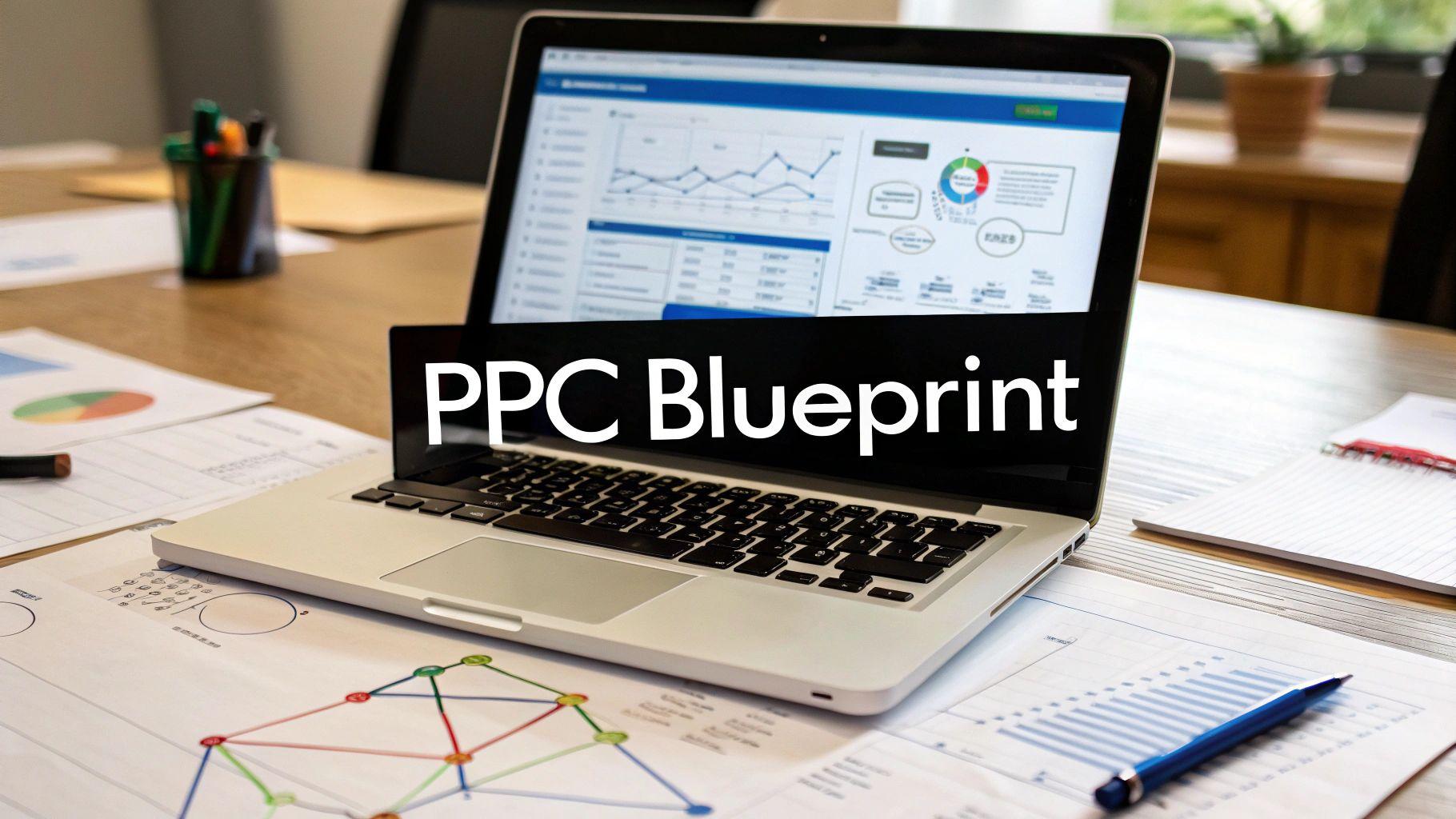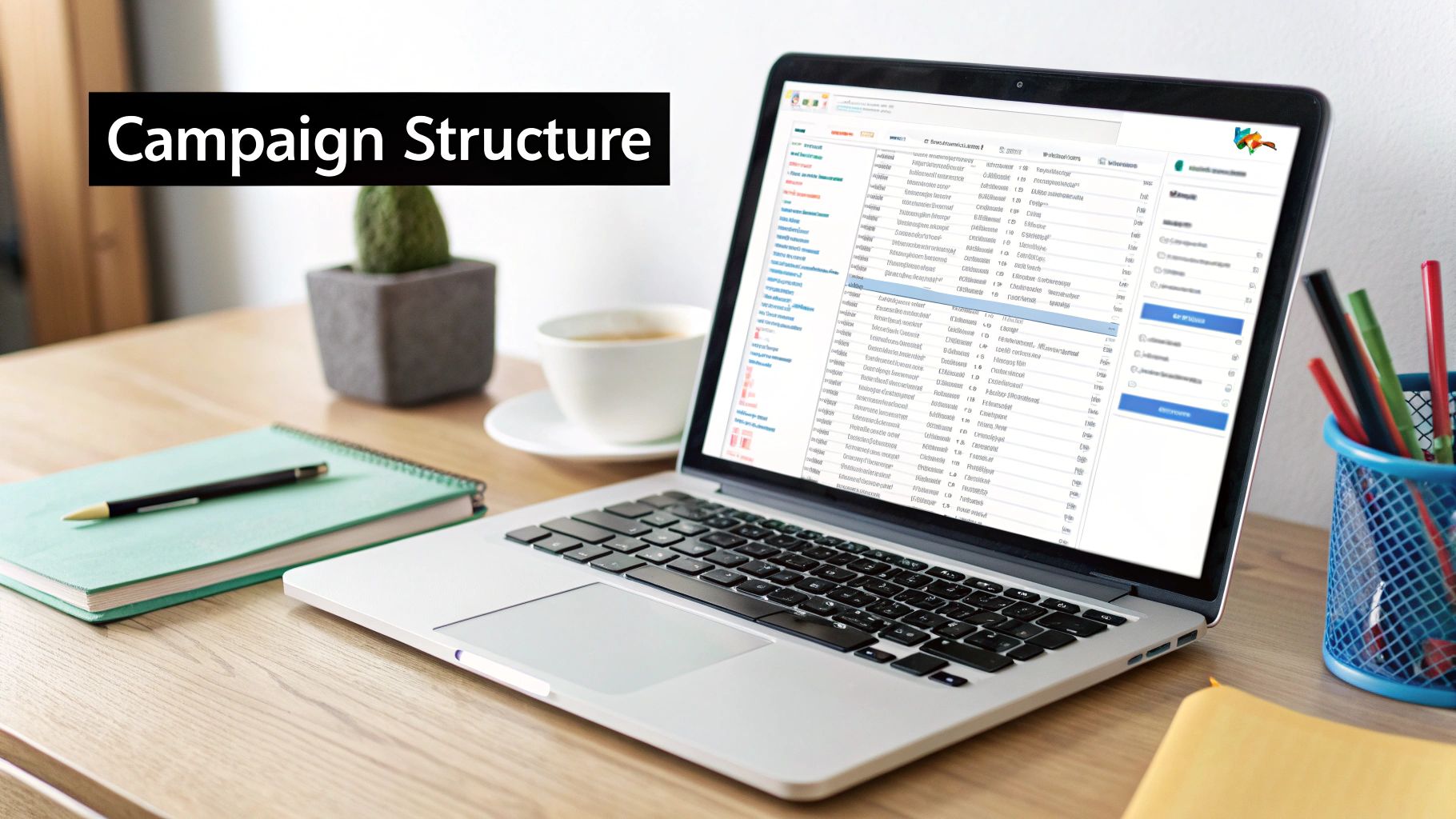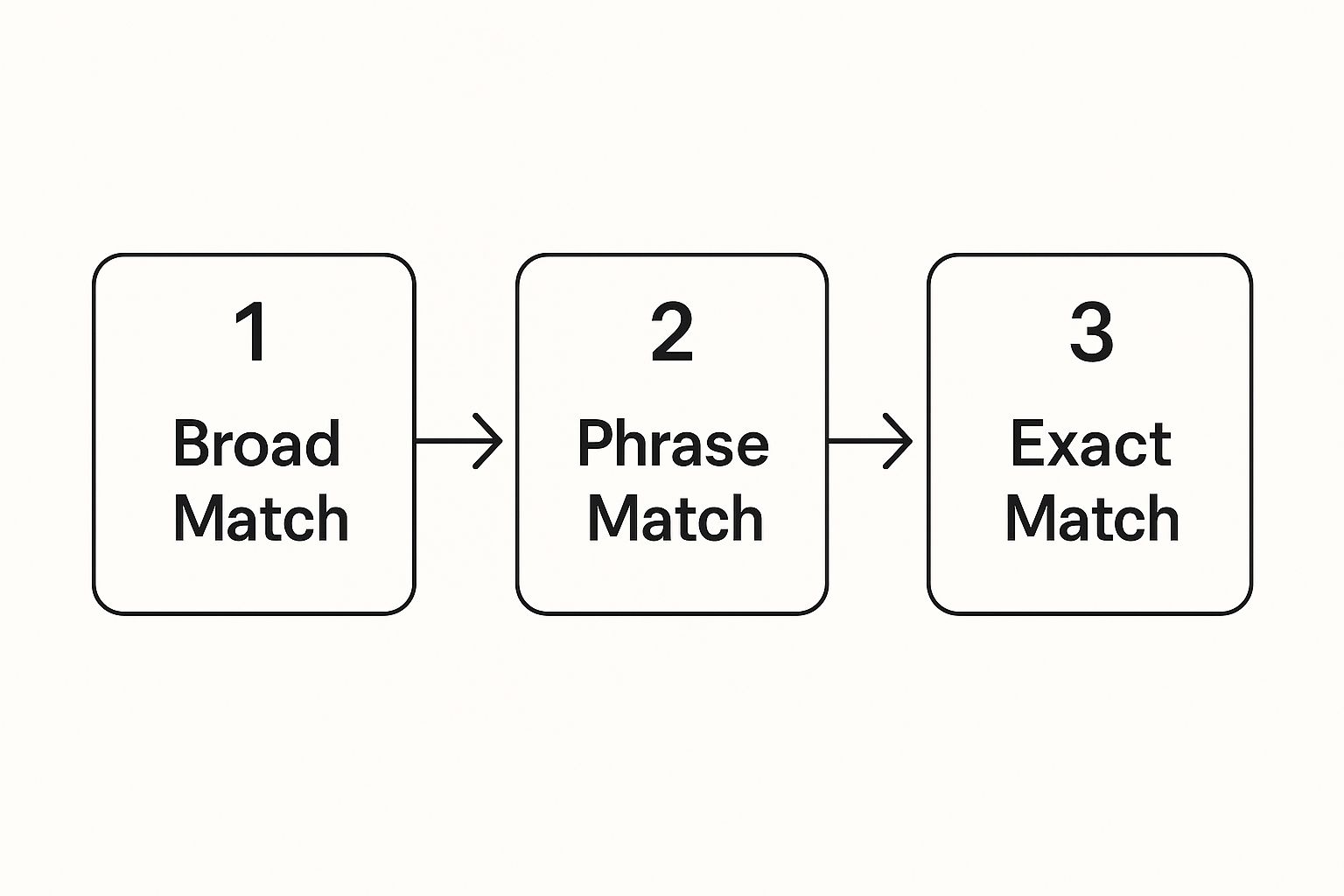A Profitable Amazon PPC Campaign Structure
Build a scalable Amazon PPC campaign structure that drives profit. Learn our proven method for naming, structuring, and optimizing your ads for maximum ROI.

Think of your Amazon PPC campaign structure as the foundation of a house. If it's weak or disorganized, everything you build on top of it will eventually crumble. A solid structure isn't about being tidy for the sake of it; it's a strategic framework that gives you control over your ad spend, makes performance analysis a breeze, and ultimately lets you scale your sales profitably.
This is the blueprint that separates the pros from the amateurs. It’s what allows you to make smart, data-driven decisions instead of just guessing.
Building Your Foundation for Profitable Campaigns

Before you even think about launching a campaign, you need to grasp the why behind a solid structure. I've seen too many seller accounts that are a complete mess—a tangled web of campaigns that makes it impossible to figure out what's working and what's just burning cash. A deliberate, organized setup from day one is your best defense against that chaos.
Think of it as the central nervous system for your entire advertising operation. It lets you see performance clearly, allocate your budget where it will have the most impact, and grow your brand without creating a bigger mess. It’s truly the key difference between a profitable account and a money pit.
Why a Good Structure Is More Critical Than Ever
Getting your campaign structure right has always been important, but now it's non-negotiable. The main reason? The cost of advertising on Amazon is climbing, and it's not slowing down.
We've seen the average cost-per-click (CPC) jump by over 10% recently, putting the average around $0.98. And if you're in a competitive niche, you can easily expect to pay over $1.50 per click. In this kind of pay-to-play environment, a granular, highly-targeted structure isn't just a "best practice"—it's a requirement for survival. You can dig deeper into how these rising costs are shaping modern PPC tactics in this guide on building a winning 2025 strategy.
A disorganized campaign structure is like trying to navigate a new city without a map. You might get somewhere eventually, but you'll waste a lot of time and fuel in the process. A proper structure is your map and GPS, all in one.
This forces us to be smarter with our ad spend. Gone are the days of broad, "set it and forget it" campaigns. Today, you have to build a system that segments everything: product variations, keyword match types, and customer intent. It's the only way to squeeze maximum value out of every dollar and protect your profit margins.
The Core Goals of a Good Structure
So, what are we actually trying to accomplish with a well-designed framework? It's about building a machine that hits several key goals at once.
- Clarity and Control: You should be able to tell at a glance which campaigns are making you money and which are just draining your budget.
- Scalability: When you want to launch a new product, you should have a clear process to plug it into your system without breaking everything.
- Data Isolation: By separating different targeting methods and match types, you get clean data that tells you exactly what's working. This is crucial for making smart optimizations.
- Strategic Budgeting: A good structure lets you funnel your budget precisely to top-performing campaigns, keywords, and products.
To put this into perspective, let's look at the foundational campaign types and how they fit into this strategic puzzle. Each one has a specific job to do.
Core Amazon Campaign Types and Their Roles
| Campaign Type | Primary Goal | Best Use Case |
|---|---|---|
| Sponsored Products | Drive sales and visibility | For targeting specific keywords and products to capture high-intent shoppers. This is your workhorse. |
| Sponsored Brands | Increase brand awareness and loyalty | For top-of-funnel advertising, showcasing your brand logo, headline, and multiple products. |
| Sponsored Display | Retargeting and audience building | For reaching shoppers on and off Amazon who have viewed your products but haven't purchased yet. |
Understanding these roles is the first step. The real magic happens when you structure them together in a way that creates a self-sustaining ecosystem for keyword harvesting and sales growth.
Designing Your Core Campaign Framework
Alright, let's get to the fun part: building the actual skeleton of your Amazon PPC operations. This is where we leave messy, confusing dashboards behind for good. What we're creating is a system that gives you total control and crystal-clear visibility. The whole point is to build a framework where you can tell at a glance what’s working, what isn't, and exactly why.
I've found the most battle-tested method is to segment campaigns by their core job. Think of each campaign as a specialist with a specific role. This clean separation is the secret to creating a logical, scalable, and—most importantly—profitable Amazon PPC campaign structure.
The Four Pillars of a Strong Campaign Structure
Your entire PPC framework should rest on four distinct campaign types. Each one has a unique strategic purpose, and by keeping them separate, you prevent your data from getting muddled. This also lets you be incredibly precise with your budget and bidding.
Here are the four pillars:
- Automatic Campaigns for Discovery: These are your R&D labs. You let Amazon’s algorithm do the heavy lifting here, sniffing out new customer search terms and product targets you might have otherwise missed.
- Manual Keyword Campaigns for Targeting: These are your workhorses. This is where you take the proven, money-making search terms from your auto campaigns and target them with surgical precision using different match types.
- Product Targeting (PAT) Campaigns for Offense and Defense: These campaigns are all about real estate. You can place your ads on your competitors' product pages (offense) or on your own (defense) to either cross-sell or stop rivals from poaching your traffic.
- Branded Campaigns for Protection: This is a simple, dedicated campaign that only bids on your brand name and its variations. It’s a low-cost, high-return way to defend your digital shelf space from sneaky competitors.
Structuring Your Keyword Campaigns
Now, let's drill down into your manual keyword campaigns. Simply dumping all your keywords into one campaign is a recipe for disaster. What you need to do is create separate campaigns for each specific match type.
This infographic paints a great picture of a keyword's typical journey, from initial discovery to becoming a top performer.

This flow shows how you'll systematically "graduate" keywords from wide-net, research-focused campaigns into tightly controlled, performance-driven ones. This process ensures you only double down on terms that have a proven history of converting for your product.
For instance, a search term pops up in your Auto campaign and gets a few sales. You'd then move it into a Broad Match campaign to test it further. If it keeps performing well, it graduates to a Phrase Match campaign. And if it proves to be a real winner there, it finally earns its spot in an Exact Match campaign, where you can confidently bid more aggressively.
Pro Tip: Your Auto campaign’s main job isn't making a profit—it’s mining for gold. Don't sweat it if its ACoS is higher than your account average. The valuable search term data it uncovers is the fuel for your highly profitable Exact Match campaigns down the line.
By isolating each match type, you stop your budget from being wasted. Your Broad Match campaign is for casting a wide net with low bids. Your Exact Match campaign is for precision strikes with higher, more competitive bids. If you were to mix them all together, your high-performing exact keywords would constantly have their budgets cannibalized by low-converting, exploratory broad match searches.
Getting this foundational structure right is the first major step toward taking full control of your ad performance and truly scaling your brand on Amazon.
A Naming Convention Is Your Secret Weapon

Let's be honest—a messy Amazon Ads account is a nightmare. A logical naming convention is the unsung hero that turns a chaotic list of campaigns into a dashboard you can actually understand at a glance. It saves you hours of digging around and helps you avoid costly mistakes.
Without one, you're just creating a massive headache for your future self. The idea is simple: embed the most important information right into the campaign and ad group names. This way, you know a campaign's purpose, what it’s targeting, and its strategy without ever having to click into the settings.
How to Build Your Naming Formula
Consistency is everything. Once you land on a standard structure, stick with it religiously. This is the foundation of a clean, scannable advertising dashboard and is a critical part of a solid Amazon PPC campaign structure.
I've tested a lot of formats over the years, and here are the core pieces of information I always include in my campaign names:
- Product Identifier: Use a short, unique code. This could be the SKU or a short product name that you'll easily recognize.
- Ad Type: Is it SP (Sponsored Products), SB (Sponsored Brands), or SD (Sponsored Display)?
- Targeting Type: Specify if it's an Auto, Keyword, or Product (PAT) targeting campaign.
- Match Type: For any keyword-based campaigns, you have to include the match type: Broad, Phrase, or Exact.
- Strategy/Goal: Add a quick descriptor for the campaign's job. Is it for Research, Performance, Defense, or a new Launch?
A simple, consistent naming system is one of the highest-leverage things you can do for your account. It takes minutes to set up but will save you countless hours of confusion and manual analysis down the road.
When you put it all together, you get a name that tells a complete story. This simple system is crucial for managing your account efficiently, especially as you start to scale with more products and campaigns.
To make this even clearer, I've put together a quick formula you can follow.
Sample Campaign Naming Convention Formula
This table breaks down how you can structure your campaign and ad group names to keep your account organized. It's a template I've refined over years of managing accounts of all sizes.
| Element | Example | Purpose |
|---|---|---|
| Ad Type | SP | Instantly identifies the ad format (Sponsored Products). |
| Product SKU/ID | BYM-01 | Links the campaign directly to a specific product. |
| Targeting Type | KW or PAT | Shows if it's Keyword or Product Attribute Targeting. |
| Match/Targeting Specifics | Exact | Specifies the keyword match type or targeting subtype. |
| Strategy | Performance | Explains the campaign's goal (e.g., profit, research). |
Using a clear formula like this means anyone, including a future team member or even yourself six months from now, can immediately understand what's going on inside your ad account.
Real-World Naming Examples
So, how does this actually look in practice? Let's use a fictional product, a "Blue Yoga Mat" with the SKU BYM-01, to show you.
- Auto Campaign:
SP | BYM-01 | Auto | Research- This name tells me it’s a Sponsored Products campaign for our Blue Yoga Mat. It's using Automatic targeting, and its primary job is to find new, profitable search terms.
- Exact Match Campaign:
SP | BYM-01 | KW - Exact | Performance- Here we have another Sponsored Products campaign for the same mat, but this one is targeting hand-picked keywords on an Exact match. The goal here is pure performance and profit.
- Competitor Targeting Campaign:
SP | BYM-01 | PAT - Competitors | Aggressive- This is a Product Targeting (PAT) campaign where we are aggressively showing up on our competitors' product detail pages.
This level of detail makes sorting and filtering your campaigns incredibly simple. With a quick search, you can isolate all your "Performance" campaigns or see how all campaigns for "BYM-01" are doing. This is how you make your Amazon PPC campaign structure smarter, not harder.
This is where the real magic happens in Amazon PPC—down in the trenches at the ad group level. So many sellers make the costly mistake of just dumping dozens of unrelated keywords into a single ad group. It feels efficient, but it’s a surefire way to kill your relevance, send your ACoS through the roof, and make any real optimization a total nightmare.
If you want real control, you have to get granular.
What does that mean? It’s simple, really. For every specific thing a customer searches for, the keyword you bid on and the ad they see should be a perfect match. When someone types in "red leather dog collar," your ad for that exact product, triggered by that exact keyword, needs to show up. This tight alignment is what sends your click-through rates (CTR) and, more importantly, your conversion rates soaring.
Ditching SKAGs for Thematic Ad Groups
For a while, the gold standard was the Single Keyword Ad Group (SKAG). The idea was simple: one ad group, one keyword. And while it worked for relevance, it often created a monster of a campaign structure that was nearly impossible to manage, especially if you have more than a handful of products.
A much smarter, more modern approach is using Thematic Ad Groups.
Instead of one keyword, you group a small, tightly-knit cluster of keywords that all share the same basic search intent. This way, you keep that crucial relevance high without drowning yourself in thousands of ad groups.
Let's stick with our "Blue Yoga Mat" (SKU: BYM-01) example. Inside your SP | BYM-01 | KW - Exact | Performance campaign, your ad groups could look something like this:
- Ad Group: Blue Yoga Mat - Core
- Keywords: "blue yoga mat," "yoga mat blue"
- Ad Group: Blue Yoga Mat - Eco-Friendly
- Keywords: "eco friendly blue yoga mat," "sustainable blue yoga mat"
- Ad Group: Blue Yoga Mat - Thick
- Keywords: "thick blue yoga mat," "extra thick blue yoga mat"
See how that works? This structure immediately gives you more control. Maybe you've found that shoppers looking for "eco-friendly" mats are willing to pay more, so you can confidently bid higher on those terms. At the same time, the "thick" keywords might be super competitive, requiring a more cautious bidding strategy.
Your Keyword Harvesting Machine
This granular, thematic ad group structure is the engine of what I call a keyword harvesting system. The entire point is to have a systematic process for finding winning customer search terms in your research campaigns and moving them into your performance campaigns where you have complete control over your bids.
It’s a constant cycle of discovery and optimization that never really stops.
- Discover: Your Automatic campaign uncovers a gem of a search term that's converting well, like "non slip blue yoga mat."
- Test: You add that term as a phrase match into your research campaign. This lets you see how it performs and what other related searches pop up.
- Isolate: Once you've confirmed it's a profitable keyword, you "graduate" the exact term "non slip blue yoga mat" into its own new thematic ad group within your performance-focused Exact Match campaign.
- Negate: This is the part everyone forgets. You must add "non slip blue yoga mat" as a negative exact match in both your Auto and Phrase match campaigns.
Why is negating so important? If you skip this step, your own campaigns will start bidding against each other for the same search term. You'll literally be driving up your own costs. Negating the graduated term forces Amazon to serve the ad from your highly optimized Exact Match campaign, where you've set a precise, profitable bid for that specific search.
Failing to do this creates internal chaos, jacking up your CPCs and turning your performance data into a muddy mess.
This clean separation of traffic is what separates amateur sellers from the pros. It's the hallmark of a truly professional Amazon PPC campaign structure. Your research campaigns are left to do their job—researching—while your performance campaigns focus on one thing: converting your most valuable customers. This disciplined process is how you turn a chaotic ad account into a predictable, profit-driving machine.
Future-Proofing Your Structure with Automation and AI

A solid Amazon PPC campaign structure isn’t just about getting results today. It’s about building something that can evolve. Amazon advertising is changing fast, and tools that use automation and AI are no longer a luxury—they're becoming essential for keeping up.
The trick is that you have to build a structure that these tools can actually understand and work with. An AI can't make sense of a messy account. To do its job, it needs clear data, distinct campaigns, and specific goals.
How Smart Tools See Your Campaigns
I like to think of automation tools as highly skilled but very literal employees. You wouldn't hire a star salesperson and just hand them a jumbled, random list of phone numbers. You’d give them a clean, organized list of qualified leads. Your campaign structure is that list.
This is why having clear campaign goals is so critical. An AI tool can manage a "Launch" campaign completely differently than a "Profitability" campaign, but only if you’ve set them up as separate entities in the first place.
- For Launch Campaigns: You can tell your automation software to bid aggressively for visibility. The goal is impressions and clicks, not ACoS, so the tool will prioritize getting your product seen.
- For Profitability Campaigns: For these, you can instruct the same tool to hit a strict target ACoS. It will automatically adjust bids downwards to protect your margins on every possible sale.
If you lump everything together, your automation tools are basically flying blind. They'll apply a single, one-size-fits-all logic that will be too conservative for your launch campaigns and too wasteful for your profitability campaigns.
A well-built campaign structure creates the perfect playground for AI. It gives algorithms the clear boundaries they need to make smart, data-driven decisions that align with your strategy.
Using Amazon’s Own Automation
You don't need to jump straight to expensive third-party software. Amazon's own dynamic bidding strategies are a powerful (and free) form of automation you can start using right away.
- Dynamic bids - down only: This is the safest bet. Amazon will simply lower your bid in real-time if its algorithm thinks a click is unlikely to lead to a sale.
- Dynamic bids - up and down: This is more aggressive. You’re giving Amazon permission to increase your bid—by up to 100% for top-of-search placements—if it sees a high chance of conversion. It can be incredibly effective, but you need to watch it.
By setting these bidding rules at the campaign level, you add another layer of automated control that ties directly into your structure. For instance, you might use "up and down" bidding on your proven, high-converting Exact Match campaigns while sticking to the safer "down only" setting for your broader research campaigns. It’s all about aligning the level of risk with the goal of each campaign.
The role of artificial intelligence is only going to grow from here. The tools of tomorrow will offer even more granular audience targeting and make bid changes based on live shopper behavior. By building a clean, goal-driven account structure today, you're setting yourself up to easily adopt these powerful new features the moment they become available. To learn more, check out this guide on the future of AI-driven PPC advertising.
Got Questions About Your PPC Campaign Structure?
Even with the best plan laid out, you're bound to hit a few questions when you start building everything in Seller Central. That's perfectly normal. Let's walk through some of the most common ones I get from sellers, so you can clear up any confusion and get your campaigns launched with confidence.
These are the real-world sticking points that often stop people in their tracks. Getting them sorted out is what turns a good plan on paper into a profitable machine.
How Many Campaigns Should I Run for a Single Product?
There isn't a single magic number here, but for one product, a great starting point is usually a set of four to five campaigns. This isn't about making things complicated just for the sake of it. It’s about building a structure that gives you maximum control over your bids and budget.
For a single SKU, a solid starter setup usually looks like this:
- One Automatic Campaign: Think of this as your research lab. Its only job is to mine for new, high-converting search terms directly from Amazon's algorithm.
- Three Manual Keyword Campaigns: This is where you put your research to work. You'll want to separate these by match type—one for Broad, one for Phrase, and one for Exact. Why? Because you'll want to bid differently on a proven, high-converting Exact match term than you would on a more speculative Broad match term.
- One Product Targeting (PAT) Campaign: This campaign is for both offense and defense. You'll target competitor product pages (offense) and your own product listings (defense) to cross-sell or upsell.
This kind of segmentation is the foundation of good PPC management. It lets you funnel your ad spend where it performs best and gives you a crystal-clear view of what's actually driving your sales.
What's the Difference Between a Campaign and an Ad Group?
It’s easy to get these two mixed up. The simplest way to think about it is like a filing cabinet.
The campaign is the whole drawer. It has one overall daily budget and a single, clear objective (e.g., "Sponsored Products - Auto - Research").
The ad groups are the folders inside that drawer. Each ad group holds a tight, specific group of keywords or product targets, along with the ad for the product that's most relevant to that group. You use campaigns to control budget and strategy, and ad groups to make sure your keywords and ads are as relevant to each other as possible.
A well-organized account is like a well-organized toolbox. You always know where the hammer (your Exact Match campaign) and the tape measure (your Auto campaign) are. You can grab the right tool for the job without fumbling around.
When Should I Create a New Campaign Instead of a New Ad Group?
This is a crucial question, and the answer directly affects how much control you have. The rule of thumb is pretty simple.
Create a new campaign when you need to:
- Set a completely separate daily budget.
- Test a fundamentally different bidding strategy (like an aggressive "up and down" strategy versus a more conservative "down only" one).
- Target a different collection of your products with a unique goal, such as launching a new product line.
Create a new ad group when you are simply:
- Adding a new, tightly-themed cluster of keywords that fits under an existing campaign's strategy and budget.
- Testing a small variation of a product that still aligns with the campaign's main goal.
How Does Campaign Structure Impact My ACoS?
Your campaign structure is one of the biggest levers you have for managing your Advertising Cost of Sale (ACoS). A messy, disorganized structure leads to wasted spend and a high ACoS. A clean, granular structure gives you surgical control.
By separating your exploratory Broad match keywords (which naturally run at a higher ACoS) from your proven Exact match keywords (which should have a much lower ACoS), you can be smarter with your money. You can confidently pour more budget into what’s working and cut spending on what isn’t.
This methodical process of isolating winners, cutting losers, and eliminating wasted ad spend is exactly how you bring your ACoS down over time.
Ready to stop guessing and start growing? At Headline Marketing Agency, we build and manage data-driven Amazon advertising strategies that focus on what matters most—your profitability and long-term brand dominance. We turn complex data into clear, actionable growth plans.
Discover how our expert team can scale your brand on Amazon.
Ready to Transform Your Amazon PPC Performance?
Get a comprehensive audit of your Amazon PPC campaigns and discover untapped growth opportunities.